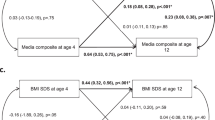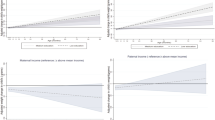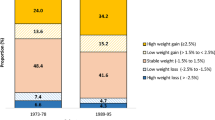Abstract
Objective:
Rapid growth, possibly occurring in critical periods in early life, may be important for the development of obesity. It is unknown whether this is influenced by postnatal exposures such as age-relevant sources of stress. Frequent house moves may be one such stressor. We aimed to examine if there is a period of growth in early life critical for the development of child obesity by age 9 years and assess the role of house moves in modifying any relationships between early life growth and obesity at age 9 years.
Design:
Prospective Australian birth cohort study.
Subjects:
In all, 392 children with serial body size measurements from birth to age 9 years.
Methods:
Standardized body mass index (z-BMI) was available for six time points (spanning birth to 3½ years), and the total number of house moves between birth and 3½ years. The outcomes considered were z-BMI and % body fat (%BF) at age 9 years. Linear regression models were used to estimate the effects of serial measurements of z-BMI and number of house moves on the outcomes.
Results:
Life-course plots showed that z-BMI at 3½ years was a statistically significant predictor of z-BMI at 9 years (β=0.80; standard error (s.e.), 0.04), whereas z-BMI at 9 months (β=−1.13; s.e., 0.40) and 3½ years (β=4.82; s.e., 0.42) were significant predictors of %BF at age 9 years. There were statistically significant interactions between the number of house moves and change in z-BMI between 9 and 12 months, such that ⩾3 house moves in early life amplified the detrimental effects of earlier rapid growth on both body size and composition at age 9 years.
Conclusion:
In the absence of evidence for a single critical period, efforts to prevent overweight and obesity are required throughout childhood. In addition, modifiable postnatal stressors may exacerbate effects of early growth on obesity in later childhood.
This is a preview of subscription content, access via your institution
Access options
Subscribe to this journal
Receive 12 print issues and online access
$259.00 per year
only $21.58 per issue
Buy this article
- Purchase on Springer Link
- Instant access to full article PDF
Prices may be subject to local taxes which are calculated during checkout



Similar content being viewed by others
References
Ebbeling CZ, Pawlak DB, Ludwig DS . Childhood obesity: public health crisis, common sense cure. Lancet 2002; 360: 473–482.
Han JC, Lawlor DA, Kimm SYS . Childhood obesity. Lancet 2010; 375: 1737–1748.
Wang Y, Lobstein T . Worldwide trends in childhood overweight and obesity. Int J Pediatr Obes 2006; 1: 11–25.
Parsons TJ, Power C, Logan S, Summerbell CD . Childhood predictors of adult obesity: a systematic review. Int J Obes Relat Metab Disord 1999; 23: S1–S107.
Dietz WH . Periods of risk in childhood for the development of adult obesity—What do we need to learn? J Nutr 1997; 127: 1884S–1886S.
Stettler N, Stallings VA, Troxel AB, Zhao J, Schinnar R, Nelson SE et al. Weight gain in the first week of life and overweight in adulthood: a cohort study of European American subjects fed infant formula. Circulation 2005; 111: 1897–1903.
Taveras EM, Rifas-Shiman SL, Belfort MB, Kleinman KP, Oken E, Gillman MW . Weight status in the first 6 months of life and obesity at 3 years of age. Pediatr 2009; 123: 1177–1183.
Reilly JJ, Armstrong J, Dorosty AR, Emmett PM, Ness A, Rogers I et al. Early life risk factors for obesity in childhood: cohort study. BMJ 2005; 330: 1357–1363.
Ong KK, Emmett P, Northstone K, Golding J, Rogers I, Ness AR et al. Infancy weight gain predicts childhood body fat and age at menarche in girls. J Clin Endocrinol Metab 2009; 94: 1527–1532.
Monteiro POA, Victora CG, Barros FC, Monteiro LM . Birth size, early childhood growth, and adolescent obesity in a Brazilian birth cohort. Int J Obes Relat Metab Disord 2003; 27: 1274–1282.
Stettler N . Nature and strength of epidemiological evidence for origins of childhood and adulthood obesity in the first year of life. Int J Obesity 2007; 31: 1035–1043.
Baird J, Fisher D, Lucas P, Kleijnen J, Roberts H, Law C . Being big or growing fast: systematic review of size and growth in infancy and later obesity. BMJ 2005; 331: 1145.
Monteiro POA, Victora CG . Rapid growth in infancy and childhood and obesity in later life—a systematic review. Obes Rev 2005; 6: 143–154.
Gundersen C, Mahatmya D, Garasky S, Lohman B . Linking psychosocial stressors and childhood obesity. Obes Rev 2011; 12: e54–e63.
Gunstad J, Paul RH, Spitznagel MB, Cohen RA, Williams LM, Kohn M et al. Exposure to early life trauma is associated with adult obesity. Psychiatr Res 2006; 142: 31–37.
Rich-Edwards JW, Spiegelman D, Lividoti Hibert EN, Jun H-J, Todd TJ, Kawachi I et al. Abuse in childhood and adolescence as a predictor of type 2 diabetes in adult women. Am J Prev Med 2010; 39: 529–536.
Huttenlocher PR . Neural Plasticity: The Effects of the Environment on the Development of the Cerebral Cortex. Harvard University Press: Cambridge, MA, 2002.
Hendricks S, Ojuka E, Kellaway LA, Mabandla MV, Russell VA . Effect of maternal separation on mitochondrial function and role of exercise in a rat model of Parkinson’s disease. Metab Brain Dis 2012; 27: 387–392.
Smith GC, Gutovich J, Smyser C, Pineda R, Newnham C, Tjoeng TH et al. Neonatal intensive care unit stress is associated with brain development in preterm infants. Ann Neurol 2011; 70: 541–549.
Garasky S, Stewart SD, Gundersen C, Lohman BJ, Eisenmann JC . Family stressors and child obesity. Soc Sci Res 2009; 38: 755–766.
McCurdy K, Gorman KS, Metallinos-Katsaras E . From poverty to food insecurity and child overweight: a family stress approach. Child Dev Perspect 2010; 4: 144–151.
Jelleyman T, Spencer N . Residential mobility in childhood and health outcomes: a systematic review. J Epidemiol Comm Health 2008; 62: 584–592.
Cummings EM, Kouros CD . Stress and coping. In: Haith MM, Benson JB, (eds). Encyclopedia of Infant and Early Childhood Development. Elsevier: Amsterdam, 2008.
Moore VM, Davies MJ, Willson KJ, Worsley A, Robinson JS . Dietary composition of pregnant women is related to size of the baby at birth. J Nutr 2004; 134: 1820–1826.
World Health Organization. Physical Status: The Use and Interpretation of Anthropometry. World Health Organization: Geneva, 1995.
Cole TJ, Freeman JV, Preece MA . Body mass index reference curves for the UK, 1990. Arch Dis Child 1995; 73: 25–29.
De Stavola BL, Nitsch D, dos Santos Silva I, McCormack V, Hardy R, Mann V et al. Statistical issues in life course epidemiology. Am J Epidemiol 2006; 163: 84–96.
Blair NJ, Thompson JMD, Black PN, Becroft DMO, Clark PM, Han DY et al. Risk factors for obesity in 7-year-old European children: the Auckland Birthweight Collaborative Study. Arch Dis Child 2007; 92: 866–871.
Ong K, Ahmed M, Emmett P, Preece M, Dunger D . Association between postnatal catch-up growth and obesity in childhood: prospective cohort study. BMJ 2000; 320: 967–971.
Cole TJ . Modeling postnatal exposures and their interactions with birth size. J Nutr 2004; 134: 201–204.
Cole TJ . The life course plot in life course analysis. In: Pickles A, Maughan B, Wadsworth M, (eds) Epidemiological Methods in Life Course Research. Oxford University Press: Oxford, 2007.
Satcher D . Include a social determinants of health approach to reduce health inequities. Public Health Rep 2010; 125 (Suppl 4): 6–7.
Cutts DB, Meyers AF, Black MM, Casey PH, Chilton M, Cook JT et al. US housing insecurity and the health of very young children. Am J Public Health 2011; 101: 1508–1514.
National Scientific Council on the Developing Child. Persistent fear and anxiety can affect young children’s learning and development Center on the Developing Child at Harvard University, Working Paper No. 9 2010.
Banwell C, Shipley M, Strazdins L . The pressured parenting environment: parents as piggy in the middle. In: Dixon J, Broom D, (eds). The 7 Deadly Sins of Obesity: How the Modern World is Making us Fat. UNSW Press: Sydney, 2007.
Danese A, McEwen BS . Adverse childhood experiences, allostasis, allostatic load, and age-related disease. Physiol Behav 2012; 106: 29–39.
Sterling P, Eyer J . Allostasis: a new paradigm to explain arousal pathology. In: Fisher S, Reason J, (eds). Handbook of Life Stress, Cognition and Health. Wiley: New York, 1988. pp 629–649.
McEwen BS . Physiology and neurobiology of stress and adaptation: central role of the brain. Physiol Rev 2007; 87: 873–904.
Ganzel BL, Morris PA, Wethington E . Allostasis and the human brain: Integrating models of stress from the social and life sciences. Psychol Rev 2010; 117: 134–174.
Cohen RA, Grieve S, Hoth KF, Paul RH, Sweet L, Tate D et al. Early life stress and morphometry of the adult anterior cingulate cortex and caudate nuclei. Biol Psychiatr 2006; 59: 975–982.
Tyrka AR, Kelly MM, Graber JA, DeRose L, Lee JK, Warren MP et al. Behavioral adjustment in a community sample of boys: links with basal and stress-induced salivary cortisol concentrations. Psychoneuroendocrinology 2010; 35: 1167–1177.
National Scientific Council on the Developing Child. Excessive stresss disrupts the architecture of the developing brain Center on the Developing Child at Harvard University, Working Paper No. 3 2005.
Rolland-Cachera M-F, Deheeger M, Bellisle F, Sempe M, Guilloud-Bataille M, Patois E . Adiposity rebound in children: a simple indicator for predicting adiposity. Am J Clin Nutr 1984; 39: 129–135.
Acknowledgements
We are grateful to the women and children who have participated in the Generation 1 study and also to other family members who have supported the study. We thank Professor Jeffrey Robinson (of the Discipline of Obstetrics and Gynaecology, The University of Adelaide) for his role in cohort establishment. We also thank Kendall Smith (of the Discipline of Public Health, The University of Adelaide) for study co-ordination and the staff members involved in interviews, database construction and data entry. This study was supported by grants from the Faculty of Health Sciences at the University of Adelaide, Dairy Research and Development Corporation, Channel 7 Children’s Research Foundation, National Health and Medical Research Council (Grants 465455, 465437, Career Development Award in Population Health 349548 to MJD, and Australian Based Public Health Training Fellowship 627033 to LCG), and Australian Research Council (ARC Future Fellowship FT100101018 to MJD).
Author information
Authors and Affiliations
Corresponding author
Ethics declarations
Competing interests
The authors declare no conflict of interest.
Rights and permissions
About this article
Cite this article
Giles, L., Whitrow, M., Rumbold, A. et al. Growth in early life and the development of obesity by age 9 years: are there critical periods and a role for an early life stressor?. Int J Obes 37, 513–519 (2013). https://doi.org/10.1038/ijo.2012.219
Received:
Revised:
Accepted:
Published:
Issue Date:
DOI: https://doi.org/10.1038/ijo.2012.219
Keywords
This article is cited by
-
Longitudinal association between the timing of adiposity peak and rebound and overweight at seven years of age
BMC Pediatrics (2022)
-
Chemical and non-chemical stressors affecting childhood obesity: a systematic scoping review
Journal of Exposure Science & Environmental Epidemiology (2018)
-
Potential selection effects when estimating associations between the infancy peak or adiposity rebound and later body mass index in children
International Journal of Obesity (2017)
-
How has child growth around adiposity rebound altered in Scotland since 1990 and what are the risk factors for weight gain using the Growing Up in Scotland birth cohort 1?
BMC Public Health (2016)



